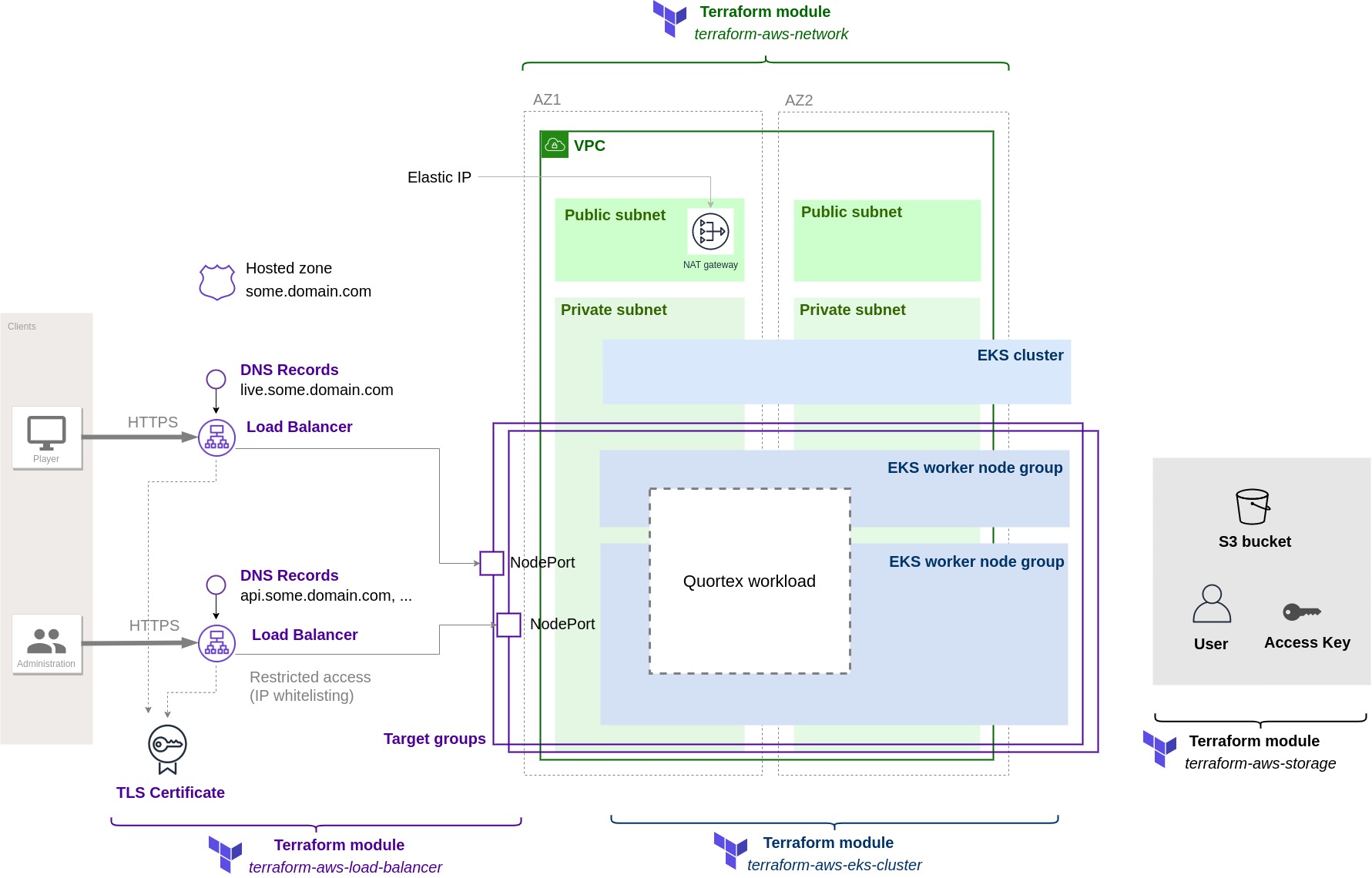A terraform module for Quortex infrastructure EKS cluster layer.
It provides a set of resources necessary to provision the Kubernetes cluster of the Quortex infrastructure on Amazon AWS, via EKS.
This module is available on Terraform Registry.
Get all our terraform modules on Terraform Registry or on Github !
This module creates the following resources in AWS:
- An EKS cluster: the control plane for Kubernetes
- EKS node groups: the Kubernetes worker nodes. There are 2 variants of nodegroups:
- node_groups: creates an EKS-managed node group (more automation, less features)
- node_groups_advanced: creates a launch template + autoscaling group, with instances that attach to the created cluster. This provides more customization (spot instances, taints...)
- An additional security group to grant access to a list of IP addresses
Example that creates 1 EKS-managed node group and 2 advanced node group (one On-Demand group and one Spot group):
module "quortex-eks" {
source = "quortex/eks-cluster/aws"
name = "quortexcluster"
kubernetes_version = "1.22"
availability_zones = ["eu-west-3b", "eu-west-3c"]
cluster_addons = {
coredns = {
version = "v1.8.7-eksbuild.3"
}
kube-proxy = {
version = "v1.22.6-eksbuild.1"
}
vpc-cni = {
version = "v1.10.1-eksbuild.1"
}
}
# values from the Quortex network module:
master_subnet_ids = module.network.private_subnet_ids
worker_public_subnet_ids = module.network.public_subnet_ids
worker_private_subnet_ids = module.network.private_subnet_ids
vpc_id = module.network.vpc_id
master_authorized_networks = {
myipaddress = "98.235.24.130/32"
}
node_groups = {
main = {
public = false
instance_types = ["t3.medium"] # t3.medium: 2 vCPU, 4GiB
scaling_desired_size = 1
scaling_max_size = 1
scaling_min_size = 1
}
}
node_groups_advanced = {
# Example of On-Demand node group:
workflow-group-ondemand = {
public = false
instance_types = ["c5.2xlarge","c5d.2xlarge"]
scaling_desired_size = 2
scaling_max_size = 3
scaling_min_size = 0
market_type = "on-demand"
spot_allocation_strategy = "" # not used when market_type is "on-demand", only for spot
spot_max_price = "" # not used when market_type is "on-demand", only for spot
spot_instance_pools = 0 # not used when market_type is "on-demand", only for spot
cluster_autoscaler_enabled = true
enabled_metrics = []
taints = {}
labels = {}
}
# Example of Spot node group:
workflow-group-spot = {
public = false
instance_types = ["c5.2xlarge","c5d.2xlarge"]
instance_filter = "AVAILABLE" # can be "AVAILABLE" (filter available instances in region), "PREFERRED" (a single available instance from an ordered list of preference) or "ALL" (no filter)
scaling_desired_size = 2
scaling_max_size = 3
scaling_min_size = 0
market_type = "spot"
spot_allocation_strategy = "capacity-optimized" # can be "capacity-optimized" (prefer instance types with lowest chances of interruption) or "lowest-price" (prefere the cheapest instance types)
spot_max_price = "" # default max is the on-demand price
spot_instance_pools = 0 # the number of pools across which to allocate your Spot Instances. The pools are determined from the different instance types. Should be between 1 and the number of instance types. Valid only when the Spot allocation strategy is "lowest-price". Should be set to 0 with "capacity-optimized".
cluster_autoscaler_enabled = true
enabled_metrics = []
taints = {} # example taints: {"spotinstance":"true:PreferNoSchedule"}
labels = {}
}
}
}Note: all items of node_groups or node_groups_advanced must have the same keys defined (but not necessarily the same values).
By default, when using node-groups-advanced, the image for the worker nodes instances is the latest AMI found whose name matches "amazon-eks-node-<kubernetes_worker_nodes_version>-v*". The image ID can be overriden using kubernetes_cluster_image_id.
When using EKS-managed nodes, the image version is selected by EKS based on kubernetes_worker_nodes_version.
This project is part of our terraform modules to provision a Quortex infrastructure for AWS.
Check out these related projects.
-
terraform-aws-network - A terraform module for Quortex infrastructure network layer.
-
terraform-aws-eks-load-balancer - A terraform module for Quortex infrastructure AWS load balancing layer.
-
terraform-aws-storage - A terraform module for Quortex infrastructure AWS persistent storage layer.
Got a question?

